Will the Midwest rain impact homesteaders?

In 2019, April showers brought May deluges. According to the National Oceanic and Atmospheric Administration, May 2019 was the second wettest month on record in U.S. history. The Midwest — particularly parts of the Corn Belt, including Nebraska, Kansas, Missouri and Illinois — experienced record-shattering rainfall. The Midwest rain has been especially damaging for farmers, who have been unable to plant in their flooded fields.
“It’s been very wet,” said Casey Hoy, faculty director at the Initiative for Food and AgriCultural Transformation at the Ohio State University. “There’s a saying [farmers] used to share with me: ‘a dry year will hurt you, a wet year will kill you.’”
Crops struggle to take root in wet soil, and plants that have already established in wet conditions face root rot and fungal pathogens. Soaked soil also lacks many beneficial microorganisms, which causes plants to lose vigor and grow susceptible to pests and disease.
Hoy explained that commodity crops like corn and soy have suffered the most this year.
“Certainly, the commodity crops are way behind,” Hoy said. “The percentage of corn and soybean land that has been planted has been way down from where it normally is this time of year.”
According to the U.S. Department of Agriculture (USDA), only 82 percent of this year’s corn crop was planted as of June 9. The agency predicts that this will result in significantly decreased acreage and yields. The USDA also projects that the price of corn will raise from $0.50 per bushel to $3.80.
How the Midwest rain will impact grocery store prices
Because the corn grown in the Midwest is used primarily for livestock feed, Hoy said not to worry about inflated prices for the sweet corn you grill at your annual Fourth of July BBQ.
However, Hoy said that farmers around the country should expect an increase in the cost of feed, which could also lead to increased meat and dairy prices in the grocery store.
For the most part, though, experts agree that grocery store prices for other produce should remain fairly stable across the country.
“On the whole, shoppers around the country can expect little change in the availability of produce,” said Matthew Kleinhenz, associate professor and extension specialist at The Ohio State University. “The supply of produce is very resilient thanks to farms being located in many areas, the expertise of farmers and other factors.”
Small growers and farmers in the Midwest, however, have already experienced a more challenging season than they have in years past. While large commodity farms may be buoyed by federal subsidies, small and speciality farmers have struggled with the impact of the wet season on their crops.
Hoy said some farmers may have lucked out depending on the season extenders and container gardens they have available.
“The smaller scale can be somewhat flexible and nimble,” Hoy said. “There is more production under high tunnels and raised beds that are not quite as susceptible to flooding.”
For shoppers buying local — not only in the Midwest, but also in other areas that have been experiencing wetter-than-average growing seasons this year, like the Western and Northeastern United States — Kleinhenz said to be patient with your favorite farmers.
“Individual shoppers looking for specific items may experience hiccups in their availability or swings in their price,” Kleinhenz said. “In that case, shoppers would want to respect the challenge the grower has faced and effort they have undoubtedly made to address the challenge.”
What farmers and growers can learn from the Midwest rain

In the long term, Hoy said growers should learn to diversify based on the experience of this wet year, no matter where they live. Hoy said that the extreme weather this year is “entirely consistent with climate change predictions,” so farmers should expect more variability in the years to come.
“There’s not a whole lot of predictability as to whether it’s going to be a wet year or a dry year,” Hoy said. “I think it speaks to the importance of diversified farming systems to be resilient in the longer term and able to adapt to new patterns of climate.”
Hoy said that, for example, pasture-based livestock would more easily adapt to the current climatic challenges than feed-based livestock production systems.
“If you have some of both, you’re going to have an easier time with this kind of weather,” Hoy said. “The key is having enough diversity in your enterprise so that you have a way of adapting regardless of what the current weather pattern is.”
